Travel Insurance for Your Everest Base Camp Helicopter Tour with Landing
First of all, we do sell travel packages. Our package does not include travel insurance for your helicopter tour. But it gives peace of mind and financial security if things do not go as planned. Here's why you should get travel insurance for your helicopter ride to Mount Everest.
Coverage for Medical Emergencies During the Everest Landing Helicopter Tour
High altitude can bring on acute mountain sickness (AMS), requiring medical attention or evacuation. Insurance helps cover medical expenses, including hospitalization and potential helicopter rescue if needed. Accidents are rare but possible, and insurance ensures coverage for emergency treatment and associated costs.
Trip Cancellation and Interruption during Everest Helicopter Tour
Unforeseen events like bad weather, political unrest, or personal illness can force you to cancel or interrupt your trip. Insurance compensates for non-refundable expenses like flights, accommodation, and tour bookings.
Choosing the Right Plan for Everest Helicopter Trip
Coverage level: Compare plans with different coverage levels for medical expenses, trip cancellations, and other benefits to choose one that fits your budget and risk tolerance.
Altitude coverage: Ensure your plan specifically covers medical expenses related to AMS and high-altitude activities.
Destination and activity specifics: Choose a plan that covers helicopter tours and activities planned during your trip.
Read the fine print: Carefully review the exclusions and limitations before purchasing insurance.
Preparation for Everest Base Camp Heli Tour
With proper preparation and a sense of adventure, your Everest Base Camp Helicopter Tour will be an experience etched in your memory forever. So, pack your bags, embrace the thrill, and prepare to be awestruck by the majesty of the Himalayas!
Physical Fitness for Everest Helicopter Tour
- While trekking isn't involved, the helicopter ride ascends rapidly to high altitudes. Ensure you're in good physical health with strong breathing and cardiovascular systems.
- Consider consulting your doctor, especially if you have any underlying health conditions or haven't been active lately.
The acclimatization process for Everest Helicopter Tour
- To prevent altitude sickness, spend a few days in Kathmandu (1,400m) or even lower villages before the tour. This allows your body to adjust to the thinner air.
- Avoid strenuous activity, stay hydrated, and rest well during this period.
Essential Gear for Everest Helicopter Tour
- Pack warm and layered clothing, including windproof and waterproof outerwear. Temperatures can drop drastically at high altitudes.
- Comfortable hiking boots are recommended for walking around Lukla or any landing points.
- Sunglasses, sunscreen, and a hat are crucial to protecting yourself from the strong sun.
- Don't forget a camera with sufficient battery and memory to capture those breathtaking views!
Essential Documentation for Everest Helicopter Tour
- Ensure your passport is valid for at least six months after your arrival date in Nepal.
- Obtain the necessary permits.
Altitude Sickness Awareness
- Be familiar with the symptoms of acute mountain sickness (AMS), like headaches, dizziness, nausea, and shortness of breath.
- Pack medication like ibuprofen or acetaminophen to manage headaches.
- Inform your pilot or tour guide immediately if you experience any symptoms. Descend to a lower altitude as soon as possible.
Other Tips
- Bring some cash for additional expenses like airport taxes or tips.
- Pack light snacks and water to keep yourself hydrated during the trip.
- Respect local customs and traditions while interacting with the Sherpa people.
- Be mindful of the fragile environment and minimize your impact on the Himalayas.
Currencies required for Everest Camp Helicopter Tour
For an Everest Camp Helicopter Tour, it's essential to be aware of the accepted currencies and payment methods. The primary currency widely accepted in Nepal is the Nepalese rupee (NPR). Therefore, it is recommended to carry Nepalese rupees for various expenses during your trip, such as local purchases, meals, and additional costs. While major currencies like the US Dollar and Euro may be accepted in some places, it's advisable to exchange a portion of your money for Nepalese rupees for convenience. Additionally, credit cards may be accepted in some urban areas, but it's crucial to have sufficient cash, especially in remote regions like Everest Base Camp, where access to banking facilities may be limited.
Packing List for Your Everest Base Camp Helicopter Tour
As you gear up for your exhilarating helicopter tour to Everest Base Camp, ensuring the right clothing and essentials is key to tackling the high-altitude environment and maximizing your enjoyment. Here's a comprehensive packing list to guide you:
 (1)-0.png)
Clothing for Mount Everest Helicopter Tour
Base layers: Moisture-wicking thermal tops and bottoms are crucial for comfort and warmth. Merino wool or synthetic fabric options are ideal.
Mid layers: a fleece pullover or zip-up jacket for added warmth and insulation.
Outerwear: a windproof and waterproof jacket and pants to shield you from unpredictable mountain weather. Choose breathable materials to avoid overheating.
Hiking pants or shorts: comfortable and durable pants or shorts for exploring Lukla or any potential landing points.
T-shirts: Long-sleeved T-shirts offer sun protection and layering options.
Socks: wool or synthetic socks for warmth and moisture management. Consider bringing an extra pair.
Underwear: Breathable and comfortable options for optimal comfort.
Hats: A warm beanie for chilly mornings and evenings, and a sun hat for daytime protection.
Gloves: Lightweight gloves to keep your hands warm during the flight and at high altitudes.
Footwear for Mount Everest Helicopter Tour
Hiking boots: waterproof and supportive boots with good traction are essential for walking around Lukla.
Sneakers are a comfortable option for the helicopter and exploring Kathmandu.
Accessories
Sunglasses: High-quality sunglasses with UV protection are vital for the intense mountain sun.
Sunscreen: Use SPF 50+ sunscreen to protect your skin from sunburn.
Lip balm: Hydrating lip balm to prevent chapped lips in the dry air.
Headlamp: Handy for early mornings or if your landing point doesn't have electricity.
Daypack: A small backpack to carry your camera, snacks, water bottle, and other essentials during the tour.
Water bottle: Stay hydrated at all times with a reusable water bottle.
Personal medication: Pack any medications you regularly take, along with over-the-counter options for headaches, nausea, and altitude sickness.
Hand sanitizer: Maintain hygiene during the trip.
Camera and extra batteries: Capture breathtaking memories with your camera and ensure you have sufficient battery life.
Cash: Bring some cash for additional expenses like airport taxes or tips.
Passport and permits: Keep your passport and all necessary permits (Sagarmatha National Park Permit, TIMS Card, Helicopter Insurance Permit, Khumbu Pasang Lhamu Rural Municipality Permit) readily accessible.
Optional
Walking poles can provide extra support and stability while walking at high altitudes.
Camera lens filters: Polarizing filters can enhance the colors of the mountains and sky.
Small binoculars: Get a closer look at distant peaks and glaciers.
Handheld GPS device: If you enjoy tracking your route.
Remember
- Pack light and layer your clothing to adjust to changing temperatures.
- Pack only what you need, as space in the helicopter is limited.
- Leave valuables at your hotel in Kathmandu if they are not essential for the tour.
- Check for any luggage restrictions specific to your chosen helicopter operator.
- With this well-thought-out packing list, you'll be fully prepared to conquer the altitude and adventure in style on your Mount Everest helicopter tour.
Safety Tips for Everest Base Camp Helicopter Flight
When preparing for a helicopter journey, it is crucial to adhere to a set of safety guidelines to ensure a secure and smooth experience. Before takeoff, it is advised to either activate airplane mode on your phone or switch it off entirely. As you approach and depart from the helicopter, maintaining a safe distance is paramount. Keep a low profile, refraining from raising your arms and avoiding the pursuit of stray objects. Following the pilot's instructions diligently is imperative for the overall safety of the flight.
Once aboard, exercise caution outside the helicopter by refraining from extending any part of your body or gadgets, and avoiding interference with the flying controls. Resist the urge to wander about the plane and await directions for disembarkation from ground personnel. Only release your seatbelt when instructed by either the captain or the ground crew. When walking beneath whirling blades, it is essential to keep your head and arms down for added safety.
Maintain your assigned location until directed otherwise by ground personnel, ensuring a disciplined and organized exit from the aircraft. The final step involves proceeding to the helicase under the guidance of the ground crew, completing a comprehensive adherence to safety measures throughout the helicopter journey.
Permits required for Everest Base Camp Helicopter Tour
Whether you are doing Everest base camp trekking or an Everest base camp helicopter tour, you will require all of the same permits. You need several permits for a smooth and legal experience. Here's a breakdown of the essential ones:
Sagarmatha National Park Permit
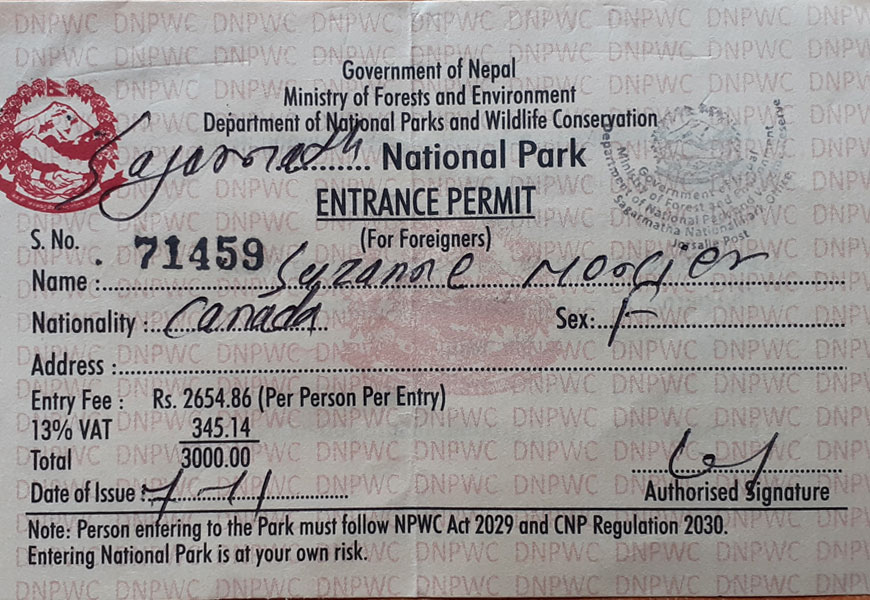
Sagarmatha National Park Permit
- This is the most crucial permit, granting you access to the Sagarmatha National Park, which encompasses the Everest region.
- You can obtain it at the National Park's office in Kathmandu or at Lukla upon arrival.
- It costs around NPR 3,000 (approximately USD 25).
TIMS (Trekkers' Information Management System) Card
.jpg)
TIMS Card (Trekkers' Information Management System)
- This card registers your travel details and helps track your movements within the park.
- Available at the Tourism Development Board office in Kathmandu or at Lukla.
- It costs around NPR 2,000 (approximately USD 16).
Khumbu Pasang Lhamu Rural Municipality Permits
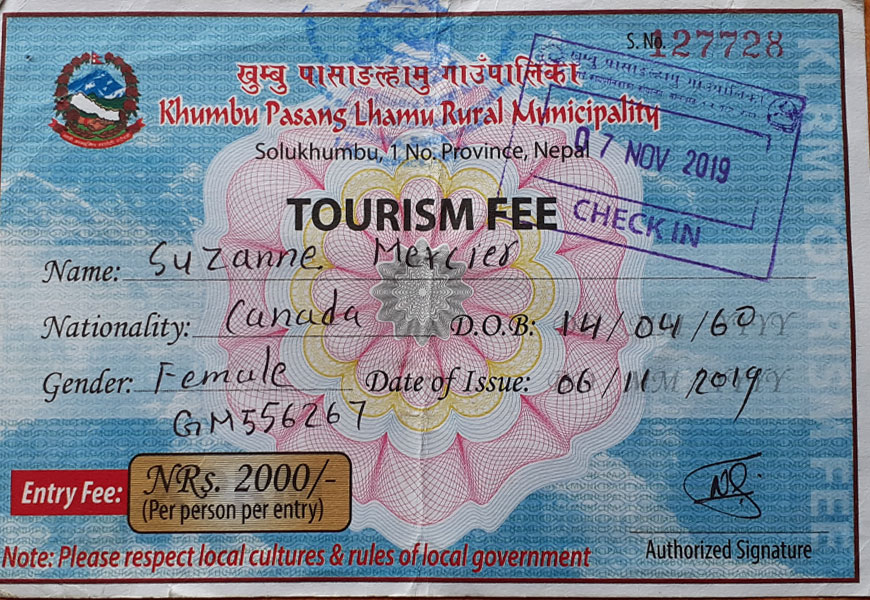
Khumbu Pasang Lhamu Rural Municipality Permit
- All foreign visitors, including SAARC (South Asian Association for Regional Cooperation) nationals, require this permit to enter the Khumbu Pasang Lhamu Rural Municipality area.
- The cost of the permit is NPR 2,000 (approximately USD 16) per person for the first four weeks.
- You can obtain the permit upon arrival at Lukla Airport if you are taking a flight.
Landing Permit
- This permit authorizes your helicopter to land at specific locations within the park, including Lukla, Everest Base Camp, or Kala Patthar.
- Usually arranged by us in advance and included in the package.
Our Helicopter Tour EBC package does not include these permits, but as per your request, we can arrange for you to add them by including the permit cost in our package.
Booking and Payment for Day Helicopter Tour to Everest
Booking is confirmed upon receipt of a non-refundable deposit or full payment, as specified.
Payment deadlines and methods will be outlined in your invoice. Failure to meet payment deadlines may result in booking cancellations.
Best Season For Everest Base Camp Helicopter Tour
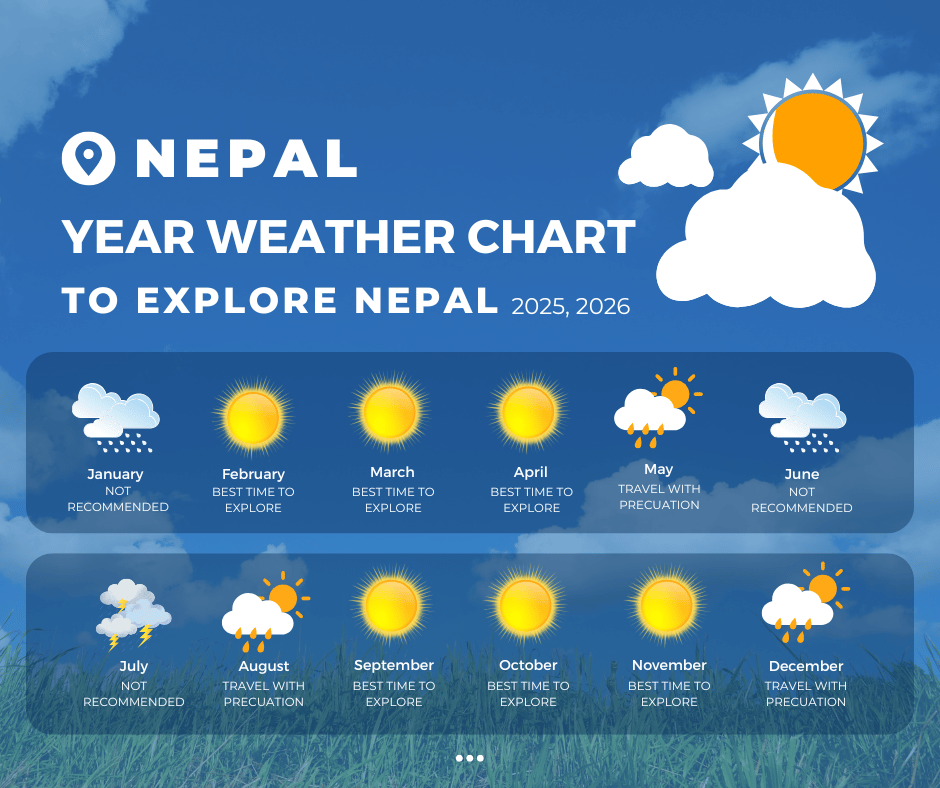
As long as the weather is clear, the Everest camp is ideal throughout the entire year. It is a necessary condition because it must be ideal for appropriate aerial experiences. Additionally, during the spring and fall months, the climate in the Everest zone is moderate, and the weather is ideal. As a result, both seasons are perfect for the Everest Base Camp Helicopter Tour.
Spring (Pre-Monsoon: March to May)
Imagine flying into a world that is just waking up. The valleys below you aren't just rocky and grey; they are brushed with the faintest green of new grasses and, as the season progresses, dotted with the most incredible, resilient wildflowers—bright magenta rhododendron blooms painting the hillsides. The air is clear and fresh after the winter, offering those famous crystal-clean views of the mountains. The giants themselves, Everest, Lhotse, and Ama Dablam, are still heavily draped in brilliant white snow from the winter, making them look especially dramatic against the deep blue sky. The trails below are lively with the first big waves of trekkers, looking like colorful ants on a mission. It’s a season of vibrant energy, renewal, and arguably the most stunning color palette of the year.
Autumn (Post-Monsoon: Late September to November)
Picture the Himalayas at their most classic and regal. The monsoon rains have washed the entire sky clean, leaving behind air so transparent it feels like you can see every detail of the rock and ice from miles away. This is the season of breathtaking, razor-sharp clarity. The landscapes feel vast and open. The fields of the lower villages are a flurry of activity as the summer's lush greens have turned to warm browns and golden yellows. With less fresh snow than in the spring, the mountain peaks are still fully visible, showcasing more of their recognizable, craggy grey rock faces. The days are bright and clear, the weather is consistent, and the atmosphere is alive with the vitality of the main trekking season. The mountains appear to be proudly displaying themselves to their visitors.
Winter (December to February)
Think of a landscape in deep, silent hibernation. The world you fly over is profoundly stark and beautiful in a completely different way. You get a genuine sense of isolated, unspoiled wilderness because the temperatures are bitterly cold and the tourist trails are nearly deserted. The whole area is white, grey, and brilliant blue, and the valleys are frequently covered in snow. With their icy summits shining in the low winter sun, the mountains are breathtakingly majestic. Even though the air can be extremely clear, the cold is a powerful force. It’s a more severe, minimalist, and solitary experience—perfect for those seeking the purest, most dramatic form of Himalayan beauty, provided you can bundle up against the chill.
Summer (Monsoon: June to August)
Now, imagine a moodier, softer version of the Himalayas. This season is a gamble. The valleys are explosively green and lush, with clouds often snagging on the lower mountain passes. With dramatic clouds framing the peaks, the views can be breathtaking when the weather breaks. But be prepared for the frequent fog and rain, which can make it hard to see the very views you came for. In a never-ending game of peek-a-boo, the mountains hide and reveal themselves behind swirling mists. It seems more mysterious and intimate. Views are not guaranteed during this season, but when you catch a fleeting glimpse of a peak through the clouds and take in the lush, rain-soaked landscape, it can still feel like a secret.
No matter when you choose to go, the Himalayas have a unique character to offer. Your season will decide which version of its grand, soul-stirring personality you get to meet.
Is the Helicopter Tour from Kathmandu to Everest Base Camp safe?
Helicopter tours are the most convenient way to reach the base camp of the world's highest peak, standing at a height of 8848.8 meters. Helicopter flights to the Everest region are completely safe. However, due to the unpredictable nature of the weather during some seasons, it gets risky. A helicopter flight to the base of Mount Everest gives you a pleasant way to experience the aerial view of the diverse landscape of Nepal. The best season for the Everest base camp is spring, which lasts from March until May when the sky is clear and the weather is pleasant, followed by autumn, which is also the festive season in Nepal, where two big and important festivals fall, which are Dashain and Tihar. This season, you will be able to experience the wide range of culture and traditions of Nepal with your Everest base camp helicopter tour. Summer and winter are comparatively riskier than spring and autumn because of the weather conditions. Summer comes with monsoons, which result in heavy rainfall that makes it difficult for helicopters to operate, and winter brings storms and foggy skies, which decrease the visibility in the flight. However, flights are possible on clear days.
Age limit for Everest Base Camp helicopter tour
Officially, there is no minimum or maximum age limit for the Everest Base Camp Helicopter Tour. This means that, in theory, anyone can participate, regardless of their age. However, there are several factors to consider before deciding if this Everest Base Camp Heli Tour is suitable for you, especially at the extremes of the age spectrum:
Considerations for younger children EBC Heli Tour
Altitude sickness: Children under 3 years old are generally not recommended for high-altitude travel due to their increased susceptibility to acute mountain sickness (AMS).
Physical endurance: The helicopter ride and any walking around landing points may be tiring for young children.
Interest and understanding: Younger children may not fully appreciate the significance of the experience and may find the long journey tiresome.
Considerations for Older Adults for EBC Heli Tour
Health conditions: Pre-existing medical conditions, especially those concerning the heart, lungs, or circulatory system, can increase the risk of AMS at high altitudes. Consult with your doctor before doing this helicopter tour.
Physical fitness: While helicopter travel doesn't involve trekking, some walking around landing points might be challenging for older adults. Ensure you are physically fit enough to handle the journey comfortably.
Balance and mobility: Ensure you have good balance and mobility to navigate potentially uneven terrain around landing points.
Accommodation for Everest Base Camp Heli Day Tour (Add-on)
The Everest base camp helicopter tour is a day trip, but if you choose to improve your experience by adding accommodation options before or after your tour, Below are some suggestions for accommodations for you to consider.
Kathmandu Accommodation
Before or after the tour, you can stay in Kathmandu and enjoy the beauty of the valley. You can even go sightseeing to historical and cultural monuments like Boudha, Pashupatinath temple, Kathmandu Durbar Square, Patan Durbar Square, and Bhaktapur Durbar
Kathmandu offers you various types of hotels in different price ranges. From low- to high-range hotels, Kathmandu offers you everything. If you want a luxury stay you can go to 5-star hotels like the Hyatt Regency, Dwarika’s Hotel, Hotel Radisson, and Soaltee Hotel. There are numerous options for you to stay in Kathmandu.
Lukla Accommodation
If you choose to add the Lukla departure option, you might consider staying in Lukla the night before or after the tour. Lukla offers limited but comfortable lodging options like Hotel Everest View Lukla and Yeti Mountain Home, which are among the best and most famous options to stay in Lukla
Namche Bazar Accommodation
Namche Bazar is a picturesque sherpa village in the Everest region where you can enjoy the traditions and culture of the people living in the village. Since Lukla is a remote village situated at a high altitude, there are limited options for hotels and among them, Hotel Everest View, Hotel Sherpaland, and Namche Bazaar are among the best and most luxurious places to stay. Namche Bazar also offers various other budget-friendly hotels.
Syangboche Accommodation
If you wish to extend your time at the Everest View Hotel, consider staying overnight in Syangboche, where you will be spending your night in a very luxurious hotel recognized as the highest altitude hotel in the world with rooms that show the best view of Mount Everest in the morning.
The Weight Limit For Everest Base Camp Helicopter Tour
A helicopter tour to Everest base camp can fly with five passengers and one captain. The passenger weight limit changes as we go. 500kg is an ideal weight for Lukla, whereas for Kalapathar or the Everest Base Camp, the ideal weight is 250 kg. The weight limit may also change a little bit depending on the types of helicopters used for helicopter tours in Nepal.
Internet and phone access on Everest Base Camp helicopter tour
While on an Everest Base Camp helicopter tour, it's important to note that internet and phone access can be limited, especially in remote areas. Here are some key points to consider:
Limited Connectivity: The Everest region, including Everest Base Camp, is known for its challenging hilly regions and high altitudes. As a result, connectivity can be unreliable or non-existent in certain areas.
Local SIM Cards: In Kathmandu and some larger towns, you can purchase a local SIM card for your phone. While this can provide some connectivity, coverage may still be limited in more remote areas.
Wi-Fi in Teahouses: In certain locations along the trekking route, teahouses (lodges) may offer Wi-Fi for a fee. However, the speed and reliability of these connections can vary, and they may not be available at higher altitudes.
Communication at Everest Base Camp: Everest Base Camp itself may have limited or no network coverage. Communication infrastructure is often set up temporarily during climbing seasons for expedition teams, but it may not be accessible for general use.
Altitude sickness during Helicopter ride to Mount Everest
While Mount Everest helicopter trips offer an incredible way to see Everest Base Camp, there is still a danger of altitude sickness, sometimes known as acute mountain sickness (AMS).
Here's a breakdown of what you need to know:
Why does it happen?
At higher altitudes, the air thins out, reducing the amount of oxygen available. Your body needs time to adjust to this lower-oxygen environment. During a helicopter ride, even though you ascend quickly, you're still exposed to lower oxygen levels, and symptoms of AMS can occur.
What are the symptoms?
- Headache (the most common symptom)
- Dizziness
- Nausea and vomiting
- Fatigue and weakness
- Loss of appetite
- Difficulty sleeping
- Rapid heartbeat
- Shortness of breath
How can you prevent it?
- Acclimatize: Spend a few days in Kathmandu or a lower-altitude village before your helicopter tour to allow your body to adjust to the thinner air.
- Hydrate: Drink plenty of water and avoid alcohol and caffeine, which can dehydrate you and worsen symptoms.
- Pace yourself: Avoid overexertion, even when walking around Kathmandu.
- Medications: Consider taking acetaminophen or ibuprofen for headaches, and consult your doctor about prescription medication if you have a history of AMS or are at high risk.
What should you do if you experience symptoms?
- Ask your captain to descend to a lower altitude as soon as possible. Even a small drop in elevation can make a big difference.
- Rest and avoid strenuous activity.
- Stay hydrated, and continue to avoid alcohol and caffeine.
- If symptoms are severe or worsen, seek medical attention or use supplementary oxygen, which is inside the helicopter. You can also use it to reduce your breathing challenges.
Remember
Taking precautions and understanding the risks can help ensure a safe and enjoyable Everest Base Camp helicopter tour landing experience, even at high altitudes. Don't let the fear of AMS deter you from this incredible adventure!
Helicopter service offered by Heli On Call in the Everest Regions
Kathmandu to Lukla Helicopter Flight
Lukla, nestled in the heart of the Everest region, beckons explorers with its rugged charm and dramatic scenery. Reaching this legendary town used to mean navigating the infamous Tenzing Hillary Airport, considered one of the world's most challenging landings. But now, a luxurious alternative unfolds: the helicopter tour to Lukla.
Skip the trek and embrace the thrill. This airborne journey whisks you past snow-capped peaks and glacial valleys, offering breathtaking panoramas like no other. Imagine soaring above the clouds, Everest majestic on the horizon, while the Khumbu Valley unfolds beneath your feet. This isn't just transportation; it's an aerial adventure etched forever in your memory.
Safety meets luxury. Ditch the anxieties of a tricky landing and savor the comfort and exclusivity of your own chopper. This isn't just about avoiding the airport's reputation; it's about prioritizing serenity and experiencing the magic of the Himalayas in style.
Beyond Lukla, a world awaits. This helicopter service transcends the usual drop-off. Extend your journey from Everest Base Camp, savoring the exhilaration of reaching the foot of the world's highest peak. Breathe in the crisp mountain air as you witness iconic landmarks like Lhotse and Makalu from a breathtaking perspective.
More than just a ride, it's an investment in experiences. Save precious hiking days to explore further, trek hidden trails, or simply soak in the tranquility of Lukla. The helicopter tour becomes your gateway to deeper adventures, unlocking the secrets of the Everest region with ease and unparalleled beauty.
Choose the smooth, the serene, and the spectacular. Choose the helicopter tour to Lukla and let the adventure begin.
Helicopter Flight from Gorakhshep to Kathmandu
The Gorak Shep to Kathmandu Helicopter Tour whisks you away from the breathtaking heights of the Everest region to the bustling city in under 1.5 hours.
No more grueling treks! This quick and efficient helicopter service bridges the gap between remote mountain locations and the comforts of Kathmandu.
Soar over the majestic Khumbu Valley, witnessing panoramic views of Mount Everest, Lhotse, and Makalu like never before. These iconic peaks, forever shrouded in mystique, will leave you awestruck as you fly past glaciers and follow the Dudh Koshi River's serpentine path.
Whether you're pressed for time, acclimatizing to the high altitude, or simply prefer a scenic shortcut, this helicopter tour is your perfect escape. Get up close and personal with the world's highest peak, witness the vast expanse of the Everest region from above, and experience the thrill of a unique Himalayan adventure.
Make memories that will last a lifetime with this accessible and unforgettable tour. Book your Gorak Shep to Kathmandu Helicopter Tour today and let the mountains take your breath away!
Everest View Hotel to Everest Base Camp Heli Flight
Thrill seekers and luxury lovers, rejoice! The Everest View Helicopter Tour by Heli On Call isn't just a sightsee; it's a symphony of luxury, breathtaking views, and unforgettable experiences.
Soar over the Himalayas in a chopper, culminating in a jaw-dropping view of Mount Everest. Touch down at the plush Hotel Everest View in the heart of Khumbu and savor a gourmet breakfast surrounded by the majestic peak. Skip the grueling trek and witness Everest's awe in comfort. Whether you're an adventurous explorer or celebrating a special occasion, this once-in-a-lifetime tour delivers.
Ready to book your unforgettable Everest encounter? Contact Heli on Call and make your dream a reality!
Pheriche to Kathmandu Helicopter Flight
Starting an adventure on Everest is exciting, and our Pheriche to Kathmandu helicopter service makes your trip even easier and faster. Pheriche, which is 4,371 meters above sea level, is an important hub for trekkers and climbers visiting the Everest Region. Our helicopter pickup service from Pheriche to Kathmandu, which is only an hour's flight away, makes it easy and affordable for people who are finishing up their adventures in the stunning Everest landscapes. The views along the way are stunning, showing off both natural and man-made sites. This makes the hour-long flight a pleasure to enjoy.
No matter if you start or end your Everest adventure in Pheriche, our services put comfort and freedom first, making sure you get back to Kathmandu quickly and safely.
Tengboche to Everest Base Camp Helicopter Flight
Take off on a unique journey in the sky with our Tengboche to Everest Base Camp Helicopter Flight. This exciting trip combines the beauty of the Himalayas with the ease of quick air travel. The helicopter ride starts in the beautiful Tengboche, which is known for its temple and stunning views. It's an exciting ride to the famous Everest Base Camp. You'll be able to see how big the Himalayas are as you fly over their beautiful peaks and deep valleys. This includes Mount Everest, which is the world's tallest peak. In addition to saving time, the flight gives you a chance to see the stunning beauty of the Everest region from a special viewing point that you can't get anywhere else.
People taking this chopper ride will be mesmerized by the wide views of the Everest Base Camp region's snow-covered peaks, rough terrain, and clean glaciers. From above, the 30-minute trip gives you a better look at the hiking route and the difficult tracks that explorers walk on. Our Tengboche to Everest Base Camp Helicopter Flight is an amazing and quick way to get to the heart of the Himalayas, whether you're a trekker who wants to add a touch of luxury to your Everest experience or a tourist who wants to see this famous area quickly and in awe.
Dingboche to Kathmandu Helicopter Flight
Skip the trek and soar to Kathmandu! Our Dingboche heli-adventure whisks you from a mountain wonder to bustling city in just 60 minutes. Ditch the long hike and marvel at snow-capped peaks, soaring valleys, and charming villages as you fly over the heart of the Everest region. Unforgettable views, effortless travel—Kathmandu awaits! Book your scenic escape today!
Finally, the Everest Base Camp Helicopter Tour with Landing from Heli on Call Pvt. Ltd. promises an amazing time with stunning views of the Himalayas and the world's largest mountain. This well-planned trip goes to the Everest View Hotel for breakfast and lands at Kala Patthar. It's a laid-back, custom-made journey. This trip gives you a unique view of the amazing Everest. It includes safety features, different flight options, and breathtaking views. It's an event that everyone should do at least once in their life. Get your spot now and start a trip you'll never forget.



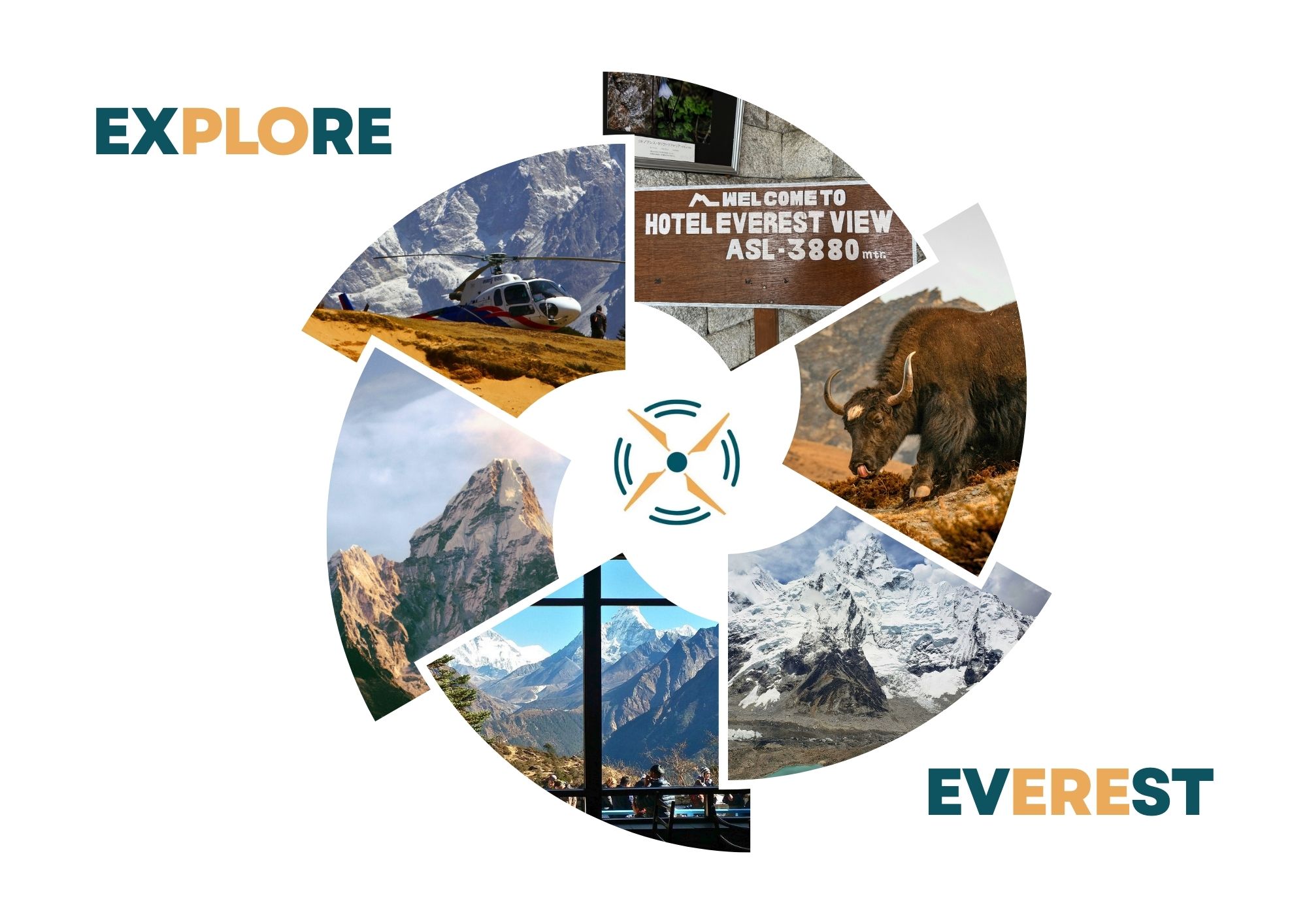
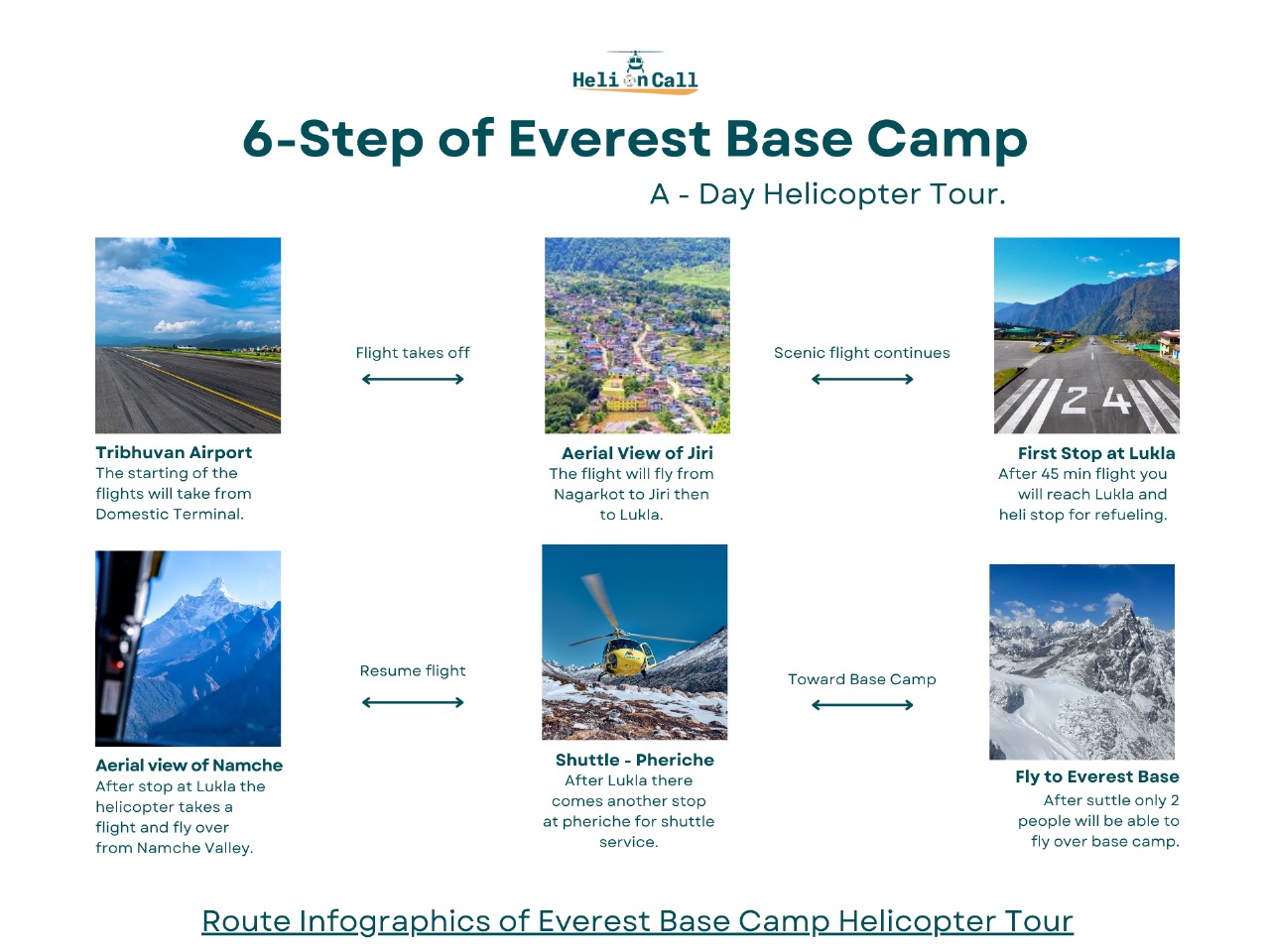
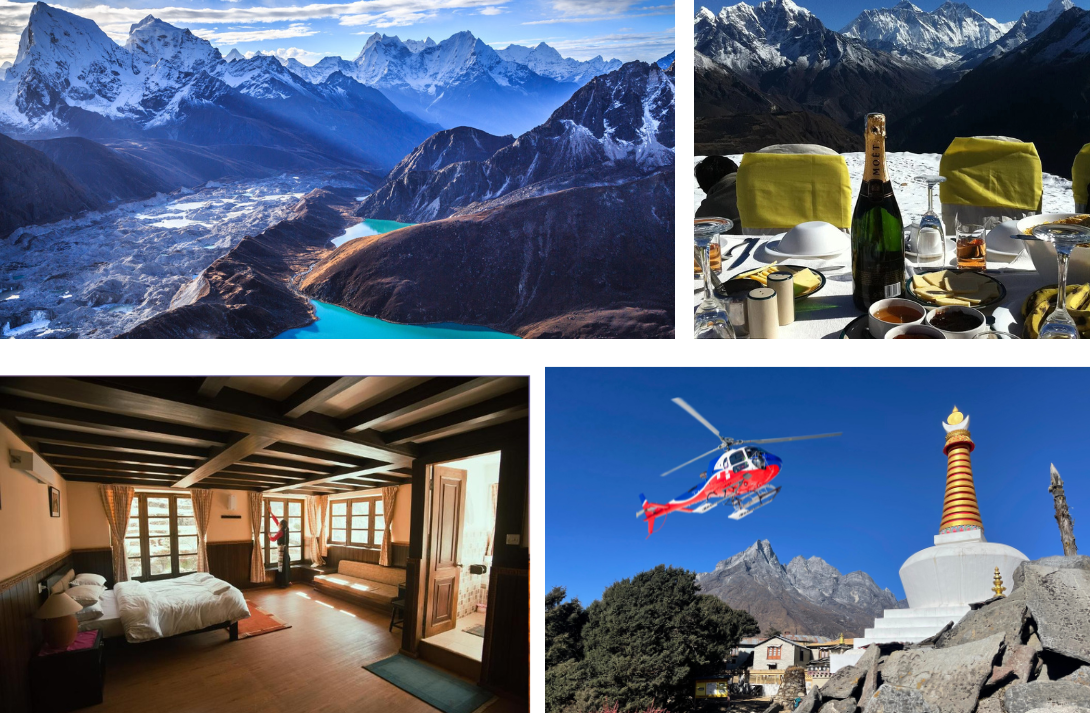
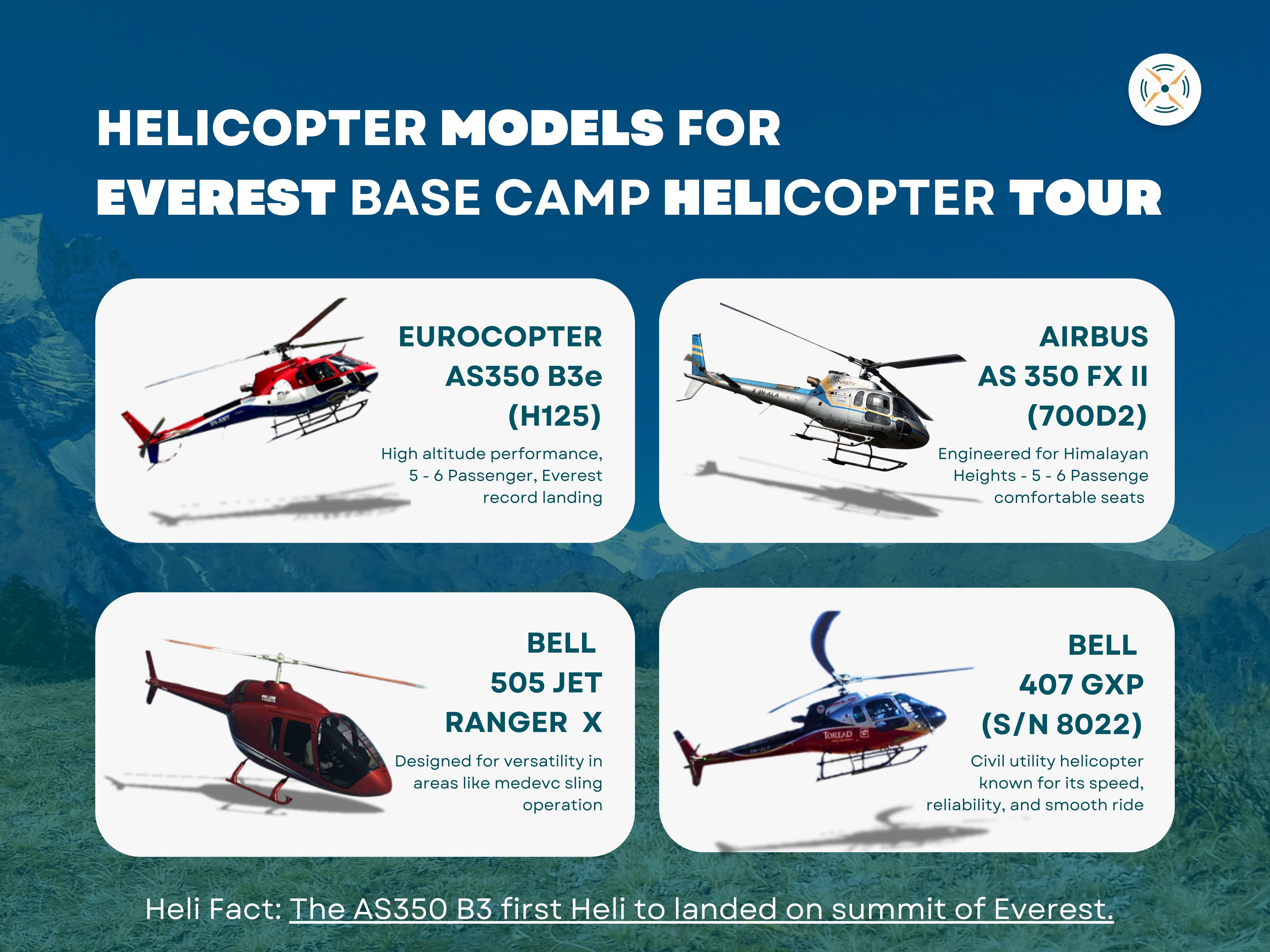

 (1)-0.png)

.jpg)








